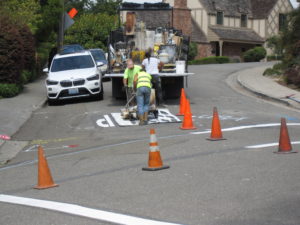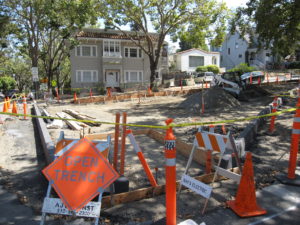Aug 25 2016
A problematic new legal interpretation of Piedmont’s decades old City Charter makes land uses interchangeable amongst zones and removes Piedmont voter from their right to decide on land use.
According to the Piedmont City Charter both classification and area of a zone must be submitted to the voters for approval prior to a change. Classification and area are separate and distinct terms in the City Charter; however, this is not recognized by the City’s new legal opinion, linked below.
After Planning Commissioners along with residents requested a written legal opinion on how the Council could find authority in the Charter to allow changes in land use without voter approval, the City finally produced a legal opinion on July 27, 2016.
This legal opinion came eight years after a seemingly extra-legal land use change in a zone from Public to Multiple family residential to allow the development of the expensive townhouses on the former site of the PG&E substation. Thc movement of property from one zone to another and changing the use was accomplished through the General Plan without voter approval as noted in the EIR for 408 Linda Avenue:
“The zoning for the project site is Zone C, Multiple Density Residential. The land use designation for the site was converted from Public/Quasi Public to Medium Density Residential with the City Council adoption of the updated City of Piedmont General Plan in April 2009.” pages 1 & 2
http://www.ci.piedmont.ca.us/publicworks/docs/408_is.pdf
According to the City Charter* voters have control of land use.
The City Charter states: “ The Council may classify and reclassify the zones established, but no existing zones shall be reduced or enlarged with respect to size or area, and no zones shall be reclassified without submitting the question to a vote at a general or special election.”
The size and area “reduced or enlarged with respect to size or area,” are separate from the classification/use. The Charter states, “no zones shall be reclassified without submitting the question to a vote at a general or special election.” Classification and area are not synonymous. According to the Charter both, classification and area must be submitted to the voters for approval.
The Charter further defines “classification” by stating: “provided that any property which is zoned for uses other than or in addition to a singlefamily dwelling may be voluntarily rezoned by the owners thereof filing a written document executed by all of the owners thereof under penalty of perjury stating that the only use on such property shall be a single-family dwelling, and such rezoning shall not require a vote of the electors as set forth above.” This clarifies that classification is specifically the use: “the only use on such property shall be a single-family dwelling, and such rezoning shall not require a vote of the electors as set forth above.”
The words “and” and “use” are pivotal in any discussion of voter rights regarding zone area and classification/land use. City terminology regarding zones states the classification/ land use assigned to the zone – Single family residential, Commercial, Public, and Multifamily – in the City Code, the General Plan, and zone descriptions.
Piedmont’s former Deputy City Attorney Linda Roodhouse, who worked closely for years with Piedmont’s long time City Attorney George Peyton wrote:
June 7th, 2012 at 2:13 pm <Context
“Staff is correct on the general scope of the Council’s legislative authority. I was the deputy City Attorney for Piedmont for many years and advised the planning department. I was also the City Attorney in Orinda for 11 years, until 2006. In both cities, I had a major role in the creation of new zoning codes. In Piedmont, the boundaries of a zone and the general land use within the zone are subject to voter approval. The City Council decides the specific rules and regulations within any zone, but the rules and regulations must be consistent with the charter description of authorized uses in a zone.” emphasis added
Linda Roodhouse, Resident
A project has now been proposed for the Shell Station on Grand and Wildwood Avenues. The City changed the land use in this zone, the Commercial zone, to allow multiple family residential, without voter approval. The City Attorney stated the zone change was allowed because there was single family residential in the Commercial zone, so multiple family residential was permitted and the zone land use was changed without voter approval. There is now yet another proposal by the Planning Department to change land use in Piedmont’s Public zone ( parks, open space, buildings, facilities, etc.) to allow commercial/business land uses without gaining voter approval.
None of the present City Council Members, Planning Commissioners, City Attorneys, City Administrative staff, including Planning were involved when in 1980 the revised City Charter was overwhelmingly approved by voters. Language in the revised Charter perpetuates long held voter rights in Piedmont. There was never any intention or mention by voters, attorneys, elected officials, or administrative staff, for voters to relinquish land use control to the City Council through the City Charter, City Codes, or General Plan, and this fact is repeated in all of these documents.
The Piedmont City Charter provides for enforcement and amendments:
“SECTION 9.06 CHARTER ENFORCEMENT
The provisions of the Charter shall be enforced, with violations punishable in the manner provided by State law and by City ordinance.
SECTION 9.07 CHARTER AMENDMENT
Amendments to this Charter may be proposed by the City Council or by the initiative process, as prescribed by this Charter and by State law.
All proposed Charter amendments shall be presented to the qualified voters of the City at a general or special election. If a majority of said voters voting upon a proposed amendment vote in favor of it, the amendment shall become effective at the time fixed in the amendment or, if no time is therein fixed, thirty (30) days after its adoption by the voters. ” emphasis added
If the City Council wants to change the language in the City Charter, the City Council must place the change on a Piedmont ballot. Changes have been made from time to time throughout the years. However in regard to taking away Piedmont voters right to determine land use decisions in Piedmont, no proposal has ever been placed on a ballot.
The current attempt to change land use in the Public zone to allow commercial uses and the previous yet not implemented change to the Commercial zone to allow multiple housing without getting approval by Piedmont voters demonstrates how land uses are being considered interchangeable from zone to zone.
A ballot measure specifying zoning changes for both size and land use could potentially receive approval by the voters, but the Piedmont electorate are being excluded from these decisions based on the City attorney’s new opinion.
The City’s new legal opinion apparently did not consider the precise language in the Charter and the extensive documented history of placing zoning changes/reclassifications before Piedmont voters. The new legal opinion appears rely on external interpretations and non-compliance with the Charter.
The Piedmont City Code states in regard to zoning:
SEC. 17.35 CONFLICTING REGULATIONS To the extent that provisions of this Chapter 17 conflict with or are inconsistent with any other ordinance or rule previously adopted, the terms of this Chapter shall control the construction, alteration or other improvements of property, except as to ordinances and rules which are subject to voter approval pursuant to the terms of the City Charter, which are not intended to be modified or repealed by any such inconsistency. (Ord. 488 N.S., 10/87)
The City Charter Article on zoning is below:
ARTICLE IX. General Provisions
SECTION 9.01 GENERAL PLAN The City Council shall adopt, and may from time to time, modify a general plan setting forth policies to govern the development of the City. Such plan may cover the entire City and all of its functions and services or may consist of a combination of plans governing specific functions and services or specific geographic areas which together cover the entire City and all of its functions and services. The plan shall also serve as a guide to Council action concerning such City planning matters as land use, development regulations and capital improvements.
SECTION 9.02 ZONING SYSTEM The City of Piedmont is primarily a residential city, and the City Council shall have power to establish a zoning system within the City as may in its judgement be most beneficial. The Council may classify and reclassify the zones established, but no existing zones shall be reduced or enlarged with respect to size or area, and no zones shall be reclassified without submitting the question to a vote at a general or special election. No zone shall be reduced or enlarged and no zones reclassified unless a majority of the voters voting upon the same shall vote in favor thereof; provided that any property which is zoned for uses other than or in addition to a singlefamily dwelling may be voluntarily rezoned by the owners thereof filing a written document executed by all of the owners thereof under penalty of perjury stating that the only use on such property shall be a single-family dwelling, and such rezoning shall not require a vote of the electors as set forth above.” emphasis added
The Piedmont Civic Association does not support or oppose specific ballot measures. The Association supports following the Piedmont City Charter.
The Piedmont Civic Association advocates that the Piedmont City Charter, essentially Piedmont’s constitution, be followed and voters’ rights be known and followed. As to the merits of voter approval of land use proposals being put forward by the Planning and Legal staff, the Piedmont Civic Association supports the Charter and allowing Piedmont voters to decide on what is their right to decide.
The City has publicly stated the cost to put a ballot measure on a General election is minor. Even so, the City has every obligation to follow the law. Questions of Charter language intent and definitions, voters must make the determination, and the Council must follow the Charter by putting the matter before the voters in regard to both area and land use in all zones.
The heritage and historic right of voters to determine land use in Piedmont cannot be removed by the new legal opinion.
The City Attorney’s recent legal zoning opinion of the City Charter can be read by clicking the link below:
Piedmont – Memo re Interpretation of Section 9.02 of City Charter




